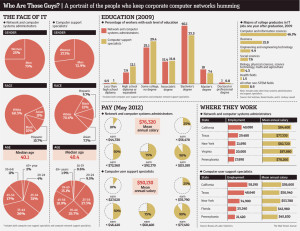Infographic: State of the IT Worker

What is the profile of the standard American IT worker? A new statistical portrait by the Wall Street Journal suggests that the demographics of the IT worker are largely what you might think, but with a few surprises.
According to the new WSJ graphic,which sources the Bureau of Labor Statistics, IT is largely comprised of white men with the median age of 40. However, there are some interesting new trends taking place in the IT space of which it is worth taking note.
For one, the attrition of women in the IT workforce seems to have hit a leveling point. According to the WSJ, women represent 25 percent of the network and computer systems administrators across industries. Likewise, women represent 30 percent of computer support specialists in the field. The National Center for Women in Information Technology (NCWIT) says this number is considerably lower than it was two decades ago. According to the NCWIT, the share of women in IT support was at an all-time high in 1991 when it reached 36 percent. It fell steadily through 2009, when it dropped to 25 percent, and as the BLS figures suggest, it has stayed relatively flat for the past four years.
While the stats show growing diversification where race is concerned, white males dominate the IT space. Among network and computer systems administrators, the WSJ figures say that 68.3 percent identify as White with 11 percent identifying as Asian, 10.7 percent identifying as Hispanic, and 10 percent identifying as Black. The numbers decline slightly for the minority groups when the focus is narrowed to computer support specialists, except one key figure – 12 percent of these specialists self-identify as Black.
Interestingly, where the IT field shows the greatest amount of diversification is where education levels are concerned. For network and system administrators, roughly 51 percent have at least a bachelor’s degree or higher. Nearly half of the field has not completed a four-year degree, with a third of the field saying that they have no degree past a high school diploma. These numbers shift even further when examining computer support specialists, where roughly 40 percent have four year degrees.
Of those with at least four-year degrees, the portrait shows that while 46.2 percent have computer and information services degrees, the majority of those in the IT have non-computer related degrees ranging from business to engineering to social sciences.
This shows great entry level potential in a field with decent potential for income. According to the infographic, the mean annual salary for network and computer systems administrators is $76,320, where computer and user support specialists make $50,130 a year on average. What’s more, among systems administrators, 75 percent of the field earn less than $92,750, meaning that an inverse 25 percent make more than that sum. These are promising numbers when you consider that systems administrator jobs are expected to increase by 28 percent through 2020, with nearly 100,000 new jobs being added in this decade in the United States, according to the Bureau of Labor Statistics.
Where will these jobs open up? According to the BLS, California is the unsurprising number one for both systems administrator and support specialist position. Texas and New York rank second and third for both computing related disciplines, with Florida, Virginia, and Pennsylvania making respectable showings, too.











